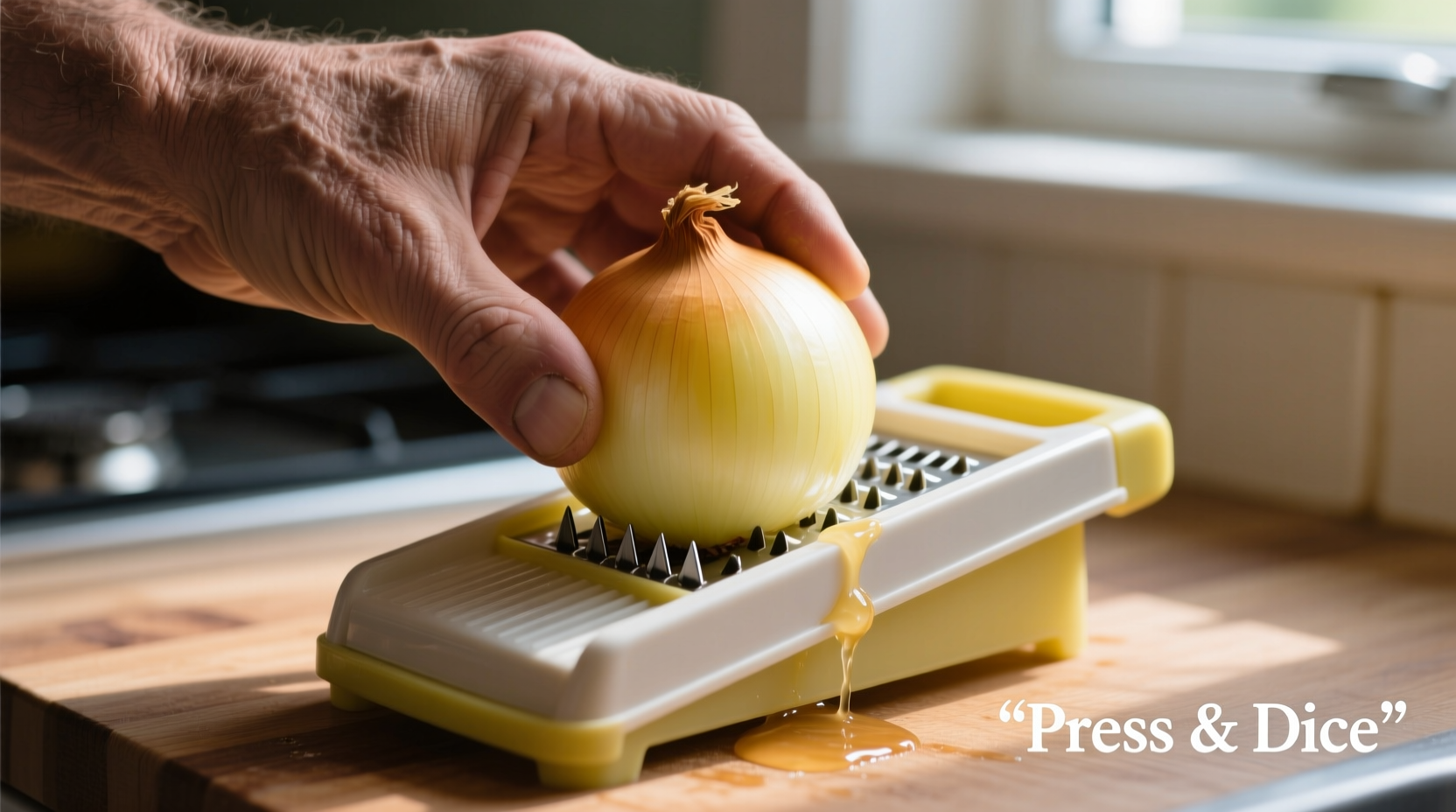Why Your Eyes Water and How Onion Dicers Solve the Problem
When you cut an onion, you rupture cells containing alliinase enzymes and sulfenic acid compounds. These combine to form syn-propanethial-S-oxide—the volatile gas that triggers tear production. Professional chefs and home cooks alike have sought solutions for centuries, from chilling onions to wearing goggles. Modern onion dicers provide the most practical solution by containing the onion during the cutting process, significantly reducing gas release.
| Preparation Method | Average Time (per onion) | Tear Production | Safety Risk |
|---|---|---|---|
| Manual Knife Chopping | 45-60 seconds | High | Moderate-High |
| Manual Press Dicer | 15-20 seconds | Low | Low |
| Electric Food Processor | 10-15 seconds | Moderate | Moderate |
Understanding Onion Dicer Types: Finding Your Perfect Match
Not all onion dicers work the same way. Your choice should align with your cooking frequency, kitchen space, and safety concerns—especially if you have children helping in the kitchen.
Manual Press-Style Dicers
The most popular home kitchen option features a container with built-in blades and a press mechanism. Simply place the onion half (cut-side down) in the container, close the lid, and press down. These models typically produce uniform 1/4-inch dice perfect for salsas, salads, and cooking. According to the USDA Food Safety and Inspection Service, these non-electric models pose fewer safety risks while maintaining food safety standards.
Electric Food Processors with Dicing Kits
For serious home cooks preparing large quantities, food processors with specialized dicing attachments offer speed but require more cleanup. The Culinary Institute of America notes that while efficient, these can sometimes over-process onions if not carefully monitored, leading to inconsistent results.
Traditional Mandoline Slicers with Dicing Attachments
These versatile tools can dice onions but require significant skill to use safely. The Consumer Product Safety Commission reports that mandoline slicers account for approximately 40,000 emergency room visits annually in the US, making them less ideal for inexperienced users.
Step-by-Step: Perfect Onion Dicing Technique
Follow this professional method for tear-free, uniform results every time:
- Preparation: Chill onions for 30 minutes before cutting (reduces gas volatility)
- Initial Cut: Cut off root end, then slice onion in half through the poles
- Peel: Remove outer skin while keeping halves intact
- Positioning: Place cut-side down in dicer container
- Dicing: Close lid securely and press down with firm, even pressure
- Release: Open container and empty diced onions into your recipe

Critical Safety Considerations You Shouldn't Ignore
While onion dicers significantly reduce knife-related injuries, proper usage matters. The CDC National Center for Health Statistics reports that kitchen cutting tools cause over 300,000 emergency department visits annually in the United States. To stay safe:
- Always ensure the lid is completely closed before pressing
- Use the provided food pusher for models requiring it
- Never attempt to retrieve stuck onion pieces with fingers—use a utensil
- Keep dicers away from children's reach when not in use
Maintenance Tips for Long-Lasting Performance
Proper care extends your onion dicer's life and maintains food safety:
- Immediate cleaning: Rinse after each use to prevent onion residue buildup
- Hand washing: Most models perform better when hand-washed (dishwashers can dull blades)
- Drying: Air-dry completely before storage to prevent moisture-related issues
- Blade inspection: Check blades monthly for dullness or damage
When NOT to Use an Onion Dicer: Important Limitations
Understanding context boundaries prevents frustration. Onion dicers work best with firm, medium-sized onions. Avoid using them with:
- Overly large onions (won't fit properly in container)
- Soft or sprouting onions (may clog the mechanism)
- When you need very fine mincing (use a knife instead)
- When preparing caramelized onions (uneven pieces cook inconsistently)
Professional Chef Insights: Maximizing Your Onion Dicer
Seasoned cooks recommend these advanced techniques:
- For consistent results, cut onions into halves that fit snugly in the container
- Place a damp paper towel under the dicer to prevent slipping
- Process one onion half at a time for optimal pressure distribution
- Use the dicer over your recipe bowl to minimize transfer steps
- For extra-fine dice, run processed onions through a second time
Common Mistakes That Ruin Your Results
Avoid these frequent errors that compromise your onion dicing experience:
- Using wet onions (reduces blade effectiveness)
- Applying uneven pressure (creates inconsistent dice)
- Overfilling the container (causes jamming)
- Using improper cutting technique before dicing
- Neglecting regular maintenance (leads to poor performance)
Final Recommendations for Home Cooks
After evaluating numerous models and techniques, the manual press-style onion dicer represents the best balance of efficiency, safety, and ease of use for most home kitchens. Look for models with non-slip bases, dishwasher-safe components (though hand washing is recommended), and clear measurement markings. Remember that proper onion preparation technique matters as much as the tool itself—combine the right dicer with the correct method for tear-free, perfectly diced onions every time.











 浙公网安备
33010002000092号
浙公网安备
33010002000092号 浙B2-20120091-4
浙B2-20120091-4